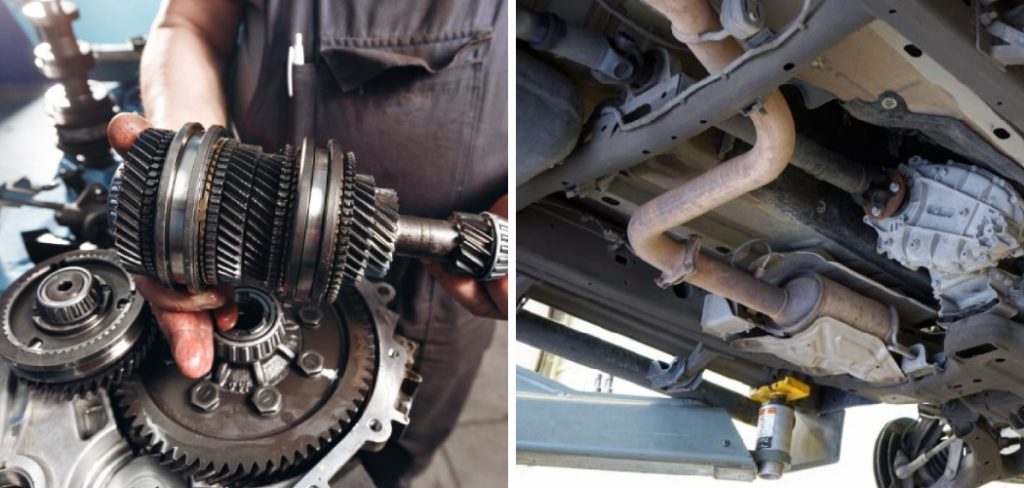For avid off-roaders, mechanics, or anyone seeking to understand their vehicle better, identifying the transfer case in your vehicle is a crucial step towards optimal performance and maintenance. The transfer case, a key component in four-wheel-drive and all-wheel-drive systems, plays a pivotal role in distributing power to the front and rear axles.

Yet, determining the specific type of transfer case your vehicle possesses can be a perplexing task, given the diverse models and variations available.
In this article, we embark on a comprehensive exploration of how to tell what transfer case i have. From decoding vehicle identification numbers (VINs) and examining owner’s manuals to physically inspecting the transfer case itself, we unravel the steps that empower you to confidently discern the transfer case in your vehicle, ensuring informed decisions for maintenance, upgrades, and overall driving experience.
Importance of Identifying the Transfer Case
When it comes to understanding and maintaining your vehicle, knowing what type of transfer case you have is crucial. The transfer case is an important component in four-wheel drive vehicles that helps distribute power to both the front and rear axles. It plays a critical role in ensuring that all four wheels are working together effectively, especially when off-roading or driving on slippery surfaces.
10 Methods How to Tell What Transfer Case I Have
1. Check the Owner’s Manual
The first and easiest way to determine what transfer case you have is by checking your vehicle’s owner’s manual. The manual will typically have a section on specifications that will list the type of transfer case installed in your vehicle. This is the most accurate way to determine your transfer case type as it is specific to your vehicle’s make, model, and year.

2. Look for Identification Tags
Many transfer cases will have identification tags or labels attached to them, which can provide important information such as the model number and serial number. These tags are usually located on the exterior of the transfer case or on one of its sides. Look for any tags or labels that may be present and note down the information provided.
3. Use an Online VIN Decoder
If you know your vehicle’s VIN (vehicle identification number), you can use an online VIN decoder to find out what type of transfer case your vehicle has. This information is typically included in the vehicle’s build sheet, which can be accessed using a VIN decoder. Some popular VIN decoder websites include CarFax, AutoCheck, and DecodeThis.
To use a VIN decoder, simply enter your vehicle’s 17-digit VIN into the search bar. The website will then provide you with a detailed report on your vehicle’s specifications, including information about the transfer case.
4. Consult with A Mechanic
If you’re still unsure about what transfer case you have, consult with a mechanic or take your vehicle to a dealership. Mechanics are trained to identify different types of transfer cases and can help you determine which one is installed in your vehicle. They can also provide you with more details about your transfer case and its specific features.
5. Check the Manufacturer’s Website
Some manufacturers have detailed information about their vehicles and their components available on their websites. You may be able to find information about your specific make and model’s transfer case by searching through the manufacturer’s website.

However, this information may not be readily available and may require some digging. The manufacturer’s website can also provide detailed diagrams and schematics of the transfer case, making it easier to identify which type you have.
6. Look for Visual Clues
Different types of transfer cases may have distinct visual characteristics that can help you identify them. For example, some may have a round shape while others are more rectangular in appearance. Additionally, certain transfer cases may have labels or imprinted markings on them that indicate the type of unit they are.
For instance, you may see “2WD” for two-wheel drive or “4WD” for four-wheel drive. These visual clues can be helpful in determining what transfer case is installed in your vehicle.
7. Measure the Input Shaft Length
Measuring the length of the input shaft on your transfer case can also help determine which type it is. Different models will have varying lengths, so comparing yours to known measurements can give you an idea of what type it is. Though this method is not as accurate as checking the serial number, it can be a good alternative if you are unable to locate the serial number on your transfer case.
8. Identify Any Markings or Stamps
Some manufacturers may stamp or engrave important information, such as model numbers or serial numbers, onto the transfer case itself. Look for any markings or stamps that may provide clues about your transfer case. These markings may be located on the case itself, the case cover, or even on any bolts or other hardware that secure the transfer case to the vehicle.
9. Use a Transfer Case Identification Guide
There are many online resources and guides available that can help you identify your transfer case based on its physical characteristics. These guides often include pictures and detailed descriptions to assist with identification. You can also check your vehicle’s owner’s manual, as it may include information on the transfer case model and type.
10. Take It to A Professional

If all else fails, take your vehicle to a professional mechanic who specializes in transmissions and transfer cases. They will be able to accurately identify your transfer case and provide you with any necessary information or repairs. However, keep in mind that this option can be expensive and you may want to consider trying other methods first.
Things to Consider When Identifying Your Transfer Case
When it comes to the performance of your vehicle, transfer case is one of the most important components. It is responsible for transferring power from the transmission to the front and rear axles. As such, it’s crucial to know what transfer case you have in order to properly maintain and diagnose any issues with your vehicle.
- Manufacturer’s Sticker: The most accurate way to determine your transfer case is by locating the manufacturer’s sticker on the transfer case itself. This sticker will have all the relevant information, such as the model number and serial number, which can be used to identify your specific transfer case.
- Vehicle Manual: If you can’t locate the manufacturer’s sticker, your vehicle manual may also have information on the type of transfer case installed in your vehicle.
- Vehicle Identification Number (VIN): Another way to determine your transfer case is by using your VIN. The 17-digit code can be decoded to reveal various details about your vehicle, including the type of transfer case it has.
- Visual Inspection: This may be more challenging for those who are not familiar with vehicle components, but simply looking at the shape and design of your transfer case can help identify it. Some common types include the chain-driven, gear-driven, and electric shift transfer cases.
- Online Resources: If all else fails, there are numerous websites and forums dedicated to vehicles that can provide you with information on how to identify your transfer case.
Common Mistakes to Avoid When Identifying What Transfer Case You Have
Not Checking the Owner’s Manual
One of the easiest ways to identify your transfer case is by checking your owner’s manual. It contains all the necessary information about your vehicle, including specifications and details about the transfer case. However, many people tend to overlook this valuable resource and go straight to other methods of identification.
Assuming All Transfer Cases Are the Same

Another mistake people make is assuming that all transfer cases are the same. In reality, there are several different types of transfer cases, each with its own unique features and specifications. Some common types include gear-driven, chain-driven, and electric shift transfer cases. It is essential to know the specific type of transfer case your vehicle has before attempting any maintenance or repairs.
Not Consulting a Professional
While it may be tempting to try and identify your transfer case on your own, it is always best to consult a professional. They have the expertise and experience to correctly identify your transfer case and provide you with accurate information. Additionally, they can also advise you on any necessary maintenance or repairs that may be needed for your specific type of transfer case.
Conclusion
In conclusion, determining the type of transfer case you have is vital for maintaining your vehicle’s performance and ensuring a smooth driving experience. This simple process of identification can save you from costly repairs and headaches down the road. With the helpful tips and methods discussed in this post, you now have all the tools needed to identify your transfer case accurately and easily.
So next time you’re under your vehicle or at the mechanic’s shop, confidently ask, “What transfer case do I have?” Armed with this knowledge, you’ll be able to make informed decisions about your vehicle’s upkeep and even impress your friends with your car expertise. Thanks for reading, and we hope this has given you some inspiration on how to tell what transfer case i have!

About
JeepFixes Team is a skilled author for Jeep Fixes, bringing 6 years of expertise in crafting a wide range of jeep fixes. With a strong background in jeep fixes work, JeepFixes Team’s knowledge spans various types of fixtures, from decorative pieces to functional hardware, blending precision with creativity. His passion for jeep fixes and design has made him a trusted resource in the industry.
Professional Focus:
Expert in Jeep Fixes : JeepFixes Team aesthetic specializes in creating durable and innovative jeep fixes, offering both appeal and functionality. His work reflects a deep understanding of jeep fixes techniques and materials.
Sustainability Advocate : He is dedicated to using sustainable practices, ensuring that every fixture is crafted with eco-friendly methods while maintaining high-quality standards.
In his writing for jeep fixes, JeepFixes Team provides valuable insights into the latest trends, techniques, and practical advice for those passionate about jeep fixes, whether they are professionals or DIY enthusiasts. His focus on combining artistry with engineering helps others discover the true potential of jeep in design.
